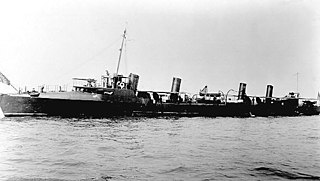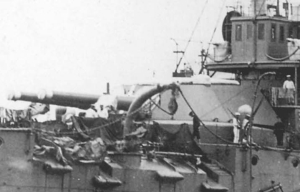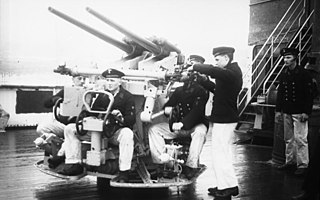Related Research Articles

The Pennsylvania class of six armored cruisers served in the United States Navy from 1905 to 1927. All six were renamed for cities 1912–1920, to make the state names available for the new battleships beginning with the Pennsylvania-class battleships. All of these served during World War I, with California being the only ship of the class to be lost. The remaining five armored cruisers were scrapped between 1930 and 1931 in accordance with the London Naval Treaty.

The Mark 60 CAPTOR is the United States' only deep-water anti-submarine naval mine. It uses a Mark 46 torpedo contained in an aluminum shell that is anchored to the ocean floor. The mine can be placed by either aircraft, submarine or surface vessel. The torpedo, once placed, can last anywhere from weeks to months underwater. The original production contract of the CAPTOR mine was awarded to Goodyear Aerospace in 1972, and entered service in 1979. It was hoped to reduce minefield costs and used in the creation of a barrier of the "Greenland-Iceland-United Kingdom gap to interrupt Soviet submarines in the event that deterrence failed."

Three Truxtun-class destroyers were built for the United States Navy. Part of the original 16 destroyers authorized by Congress on 4 May 1898 for the fiscal year 1899 program, they were commissioned in 1902. They were very similar to their Bainbridge-class contemporaries, except for mounting six 6-pounder (57 mm) guns instead of five. They were considered the most successful of the first 16 US Navy destroyers, and were succeeded by the larger Smith class.

The Hotchkiss gun can refer to different products of the Hotchkiss arms company starting in the late 19th century. It usually refers to the 1.65-inch (42 mm) light mountain gun; there were also a navy (47 mm) and a 3-inch (76 mm) Hotchkiss guns. The 42 mm gun was intended to be mounted on a light carriage or packed on two mules to accompany a troop of cavalry or an army travelling in rough country.

Belt armor is a layer of heavy metal armor plated onto or within the outer hulls of warships, typically on battleships, battlecruisers and cruisers, and aircraft carriers.

The 37 mm automatic air defense gun M1939 (61-K) is a Soviet 37 mm calibre anti-aircraft gun developed during the late 1930s and used during World War II. The land-based version was replaced in Soviet service by the AZP S-60 during the 1950s. Guns of this type were successfully used throughout the Eastern Front against dive bombers and other low- and medium-altitude targets. It also had some usefulness against lightly armoured ground targets.

Diethylene glycol dinitrate (DEGDN) is an explosive nitrated alcohol ester with the formula C4H8N2O7. While chemically similar to numerous other high explosives, pure diethylene glycol dinitrate is difficult to ignite or detonate. Ignition typically requires localized heating to the decomposition point unless the DEGDN is first atomized.

The Derfflinger class was a class of three battlecruisers of the Imperial German Navy. The ships were ordered for the 1912–13 Naval Building Program of the German Imperial Navy as a reply to the Royal Navy's two new Lion-class battlecruisers that had been launched a few years earlier. The preceding Moltke class and the incrementally improved Seydlitz represented the end of the evolution of Germany's first generation of battlecruisers. The Derfflinger class had considerable improvements, including a larger primary armament, all of which was mounted on the centerline. The ships were also larger than the preceding classes. The Derfflinger class used a similar propulsion system, and as a result of the increased displacement were slightly slower.

The 37 mm gun M1 was an anti-aircraft autocannon developed in the United States. It was used by the US Army in World War II.

The QF 3-pounder Hotchkiss or in French use Canon Hotchkiss à tir rapide de 47 mm were a family of long-lived light 47 mm naval guns introduced in 1886 to defend against new, small and fast vessels such as torpedo boats and later submarines. There were many variants produced, often under license which ranged in length from 32 to 50 calibers but 40 caliber was the most common version. They were widely used by the navies of a number of nations and often used by both sides in a conflict. They were also used ashore as coastal defense guns and later as an anti-aircraft gun, whether on improvised or specialized HA/LA mounts.

The Armstrong Whitworth 12-inch naval gun of 40 calibres length was designed by and manufactured mainly by Armstrong's ordnance branch, Elswick Ordnance Company. It was intended for the Royal Navy's Royal Sovereign-class battleships, but budgetary constraints delayed their introduction. The first units were instead supplied to Japan. As the Type 41 12-inch (305 mm) 40-calibre naval gun it was the standard main battery on several early United Kingdom-built pre-dreadnought battleships of the Imperial Japanese Navy.

The Columbia-class cruisers were two protected cruisers constructed in 1890 and 1891 and used by the United States Navy. They were lightly gunned ships with only moderate armor that were built for the speed needed to overtake and destroy the fast ocean liners of the day as commerce raiders. However, the light armament and armor left these ships over-specialized and outclassed by ordinary similar sized protected cruisers that they might encounter. Also, the engines were expensive to operate and at full power the ships' range was greatly decreased. Due to the ongoing size and speed race in ocean liners, by 1907 they were outclassed in speed by the ill-fated Lusitania and the German liner Kronprinzessin Cecilie.
The Mark 35 torpedo was the first of the United States Navy deep-diving anti-submarine torpedoes designed for surface launch. This electrically propelled 21-inch (53-cm) torpedo was 162 inches long, weighed 1770 lb (803 kg), and carried a 270 lb (122.5 kg) Torpex high explosive warhead. This torpedo used one of the earliest active guidance systems and was introduced in 1949, and was classified as obsolete in the 1960s.

12 cm/45 3rd Year Type naval gun was a Japanese naval gun and coast defense gun used on destroyers, and torpedo boats of the Imperial Japanese Navy during World War II.

Hexanitrodiphenylamine (abbreviated HND), is an explosive chemical compound with the formula C12H5N7O12. Since it is made from readily available raw materials, HND was used extensively by the Japanese and less extensively by Nazi Germany during World War II but was discontinued due to its toxicity.

The 3.7 cm SK C/30 was the German Kriegsmarine's primary 3.7 cm (1.5 in) anti-aircraft gun during the Second World War. It was superseded by the fully automatic 3.7 cm FlaK 43 late in the war.
There have been a number of 21-inch (53.3cm) torpedoes in service with the Royal Navy of the United Kingdom.

The 8.8 cm SK C/35 was a German naval gun used in World War II.
The 13.2 mm Breda Model 31 was a widely used Italian heavy machine gun produced by Società Italiana Ernesto Breda and used by the Italian Navy and Italian Army during World War II. At sea it was employed as a light anti-aircraft gun, while on land it was mounted on armored command vehicles where it was used as a heavy machine gun. After World War II it remained in use aboard the patrol boats of the Guardia di Finanza.

The Canon de 37 mm Modèle 1925 was a widely used family of French anti-aircraft guns used by the French Navy during World War II.
References
- ↑ "HyperWar: War Damage Report 58: Submarine Report [Section 3]".
- ↑ Tony DiGiulian. "World War II Torpedoes of Germany". NavWeaps. Retrieved 2022-08-20.
- ↑ "Dutch Submarines: The Submarines of the Royal Netherlands Navy".
- ↑ "Explosive Ordnance Disposal - EOD | EOD | Landhelgisgæsla Íslands". Archived from the original on 2017-06-23. Retrieved 2008-04-30.
- ↑ Tony DiGiulian. "Mines of Germany". NavWeaps. Retrieved 2022-08-20.
- ↑ "Mines and Mine Laying in Iceland WWII | Landhelgisgæsla Íslands". Archived from the original on 2016-03-31. Retrieved 2008-04-30.
- ↑ "HyperWar: War Damage Report 58: Submarine Report [Section 3]".